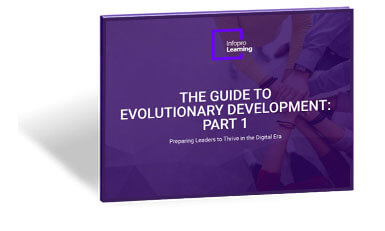Your people are the foundation of your business success. What better way to acknowledge the important role your employees play in your organization than by celebrating National Career Development Day! November is the 53rd annual National Career Development Month with Nov. 14 being a day specifically set aside to discuss how you can empower your people to achieve their highest potential.
As notorious Sir Richard Branson says, “Train people well enough so they can leave, treat them well enough so they don’t want to.” We’ve compiled several ideas for you to discuss internally with colleagues, business leaders, and L&D professionals on how your organization can attract and retain top talent by investing in their skills and career development.
Looking to fully transform leadership development for your employees? Skip right to our free Guide to Evolutionary Development.
1. Provide a best-in-class onboarding program.
Want a workforce that is excited, energized and motivated? You must invest in your employee experience, even before Day 1. So much more than perks and free snacks, a strong experience is founded on organizational values, a culture of learning and strategic onboarding.
Did you know that 20 percent of turnover happens within the first 45 days of employment?
And 1 in every 6 employees considered quitting a new job due to ineffective onboarding[1]. If you don’t get the onboarding process right, then you’ve set yourself and your employee up for failure. While onboarding isn’t the flashiest part of the HR function, it’s absolutely critical to get off on the right foot.
2. Promote knowledge sharing.
Knowledge sharing can be accomplished on any scale you can imagine. It can be as simple as encouraging internal collaboration on social intranets or facilitating weekly lunch and learns for functional departments or soft skills. But where knowledge sharing sticks the most is with mentorships.
We often here about how for generations in the workplace has created challenges on blending so many different styles of working, communication, etc. But what we don’t emphasize enough is what these generations can teach each other. Consider a formal mentorship program to connect your more experienced employees with new hires. Long-time workers will be able to help Millenials and Gen Z employees navigate office protocols and help groom them for their first leadership positions. From the other end, your people who might be wrapping up their careers can still learn from their contemporary counterparts who have a native fluency in technology that fuels our consumer experience.
3. Provide a pathway for growth.
Career growth doesn’t have to be a continuous vertical climb. A full 87% of millennials say professional development or career growth opportunities are very important to them in a job. A pathway for growth normally involves access to continued education and training. Does your leadership development program inspire employees to thrive amid today’s rapidly-evolving business challenges? If you don’t have formal learning programs, informal growth may involve job sharing or lateral movements across the organization. Just because someone isn’t moving up doesn’t mean they aren’t growing. And when you have an evergreen source of talent, your succession planning will be a piece of cake.
Hungry to learn more about how you can unlock human potential at your organization?
Check out our free 2-part Guide to Evolutionary Development. In the guide, Vice President of Leadership and Organizational Development Kathy Sherwood shares insights on why it’s time to rethink the status quo of leadership training. You’ll learn:
-
- Why your leadership development model must adapt to today’s business landscape
-
- What skills, behaviors and mindsets modern leaders must embody and cultivate in others
-
- A new approach and framework for the Evolutionary Development model





